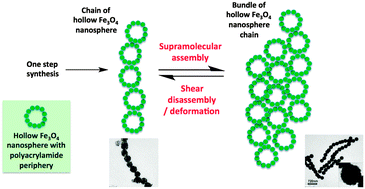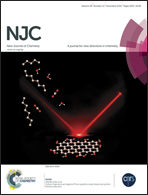Shear disassembly of hierarchical superparamagnetic Fe3O4 hollow nanoparticle necklace chains†
Abstract
Supramolecular amide hydrogen-bond interactions between bundles of necklace-like chains based on superparamagnetic hollow Fe3O4 nanoparticle beads could be indirectly quantified by shear stress and magnetorheological analyses. First, a facile magnetic field-induced method was developed for the preparation of the superparamagnetic Fe3O4 hierarchical chain structures. Primary Fe3O4 hollow nanospheres, hollow nanosphere-assembled chains, and partially hollow nanosphere-assembled chains were successfully prepared. These superparamagnetic nanoparticles and chains could be well dispersed in aqueous solutions. The magnetic hollow nanoparticle chains possess a strong magnetorheological effect in aqueous solutions. Bundle wire-like structures based on chains or nanospheres could be formed with different magnetic field alignments. The hollow nanostructure greatly strengthens the as-formed bundle wire-like structures such that the chains have a larger magnetorheological effect than that of the hollow nanospheres. It is envisaged that a specific cell transfection mechanism of chains and wires could involve a partial disassembly from bundles to individual chains/wires before endocytosis. The force that is exerted on this disassembly from bundles to individual chains/wires in a specific medium, which are quantified by shear stress and magnetorheological analyses, would shed light on cell magnetofection mechanisms.


 Please wait while we load your content...
Please wait while we load your content...